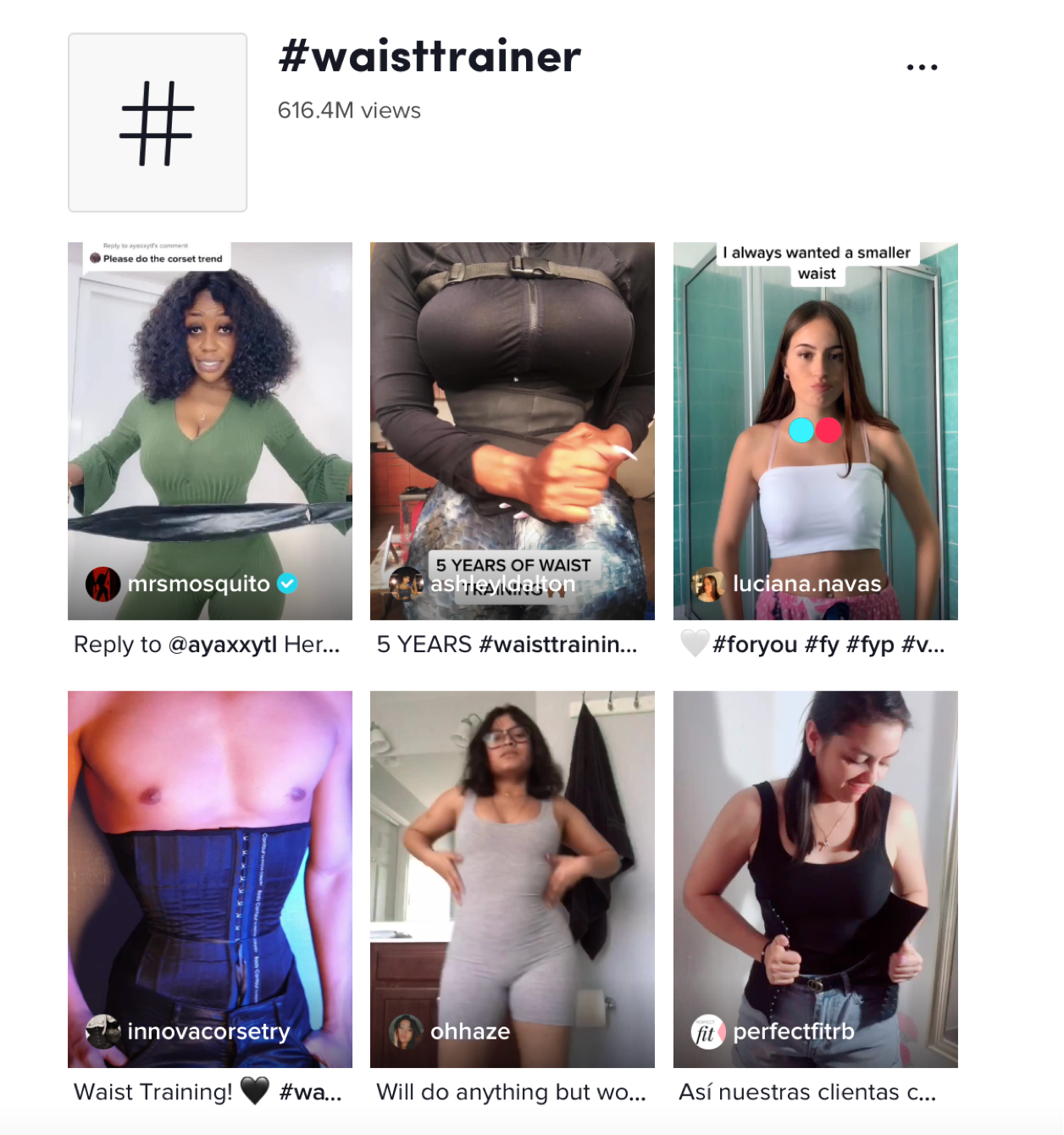TikTok’s corset challenge, the Kardashians and Spanx: Are waist trainers ruining your insides?
TikTok is flooded with people showing off their waist trainers and corsets as they strive to achieve an hourglass silhouette. But, experts warn it may come at a cost of their health, Rachel Sharp writes


Back in April, a new craze was sweeping TikTok.
Thousands of social media users were squeezing themselves into tight-fitting corsets and lip-syncing to the song “Haus of Holbein” from the Broadway musical “SIX”.
At the line “no one wants a waist over nine inches”, they would then tighten the corset to cinch in their waists, creating a drastic body shape.
It was all in the name of the so-called “corset challenge” – which quickly went viral and racked up more than 3.3 billion views.
But despite its popularity, the trend also sparked controversy, raising questions around body positivity and renewing concerns over the negative health implications of waist training.
Of course, compression garments aren’t exactly new, with corsets being worn by women since the Victorian era.
But, corsets and waist trainers have witnessed a major revival in recent years, largely thanks to the Kardashians – who have brought the hourglass figure firmly back in fashion.
When Kim Kardashian hit the red carpet at the 2019 Met Gala, it wasn’t her custom “dripping wet” Thierry Mugler dress and wet look hair that had everyone talking.
Instead, talk turned to the Mr Pearl corset the reality star was wearing underneath that gave her a cinched-in waist of extreme proportions (not caused by the removal of a rib as was first rumoured).
Kim, and her sisters Khloe and Kylie – along with many other celebrities – have all credited their enviable curves to the help of corsets and waist trainers.
Put simply, waist training involves wearing a type of compression garment around the waist to sculpt the body into an hourglass silhouette.
Advocates claim wearing one for up to eight hours a day can shave four inches off the waist, create more dramatic curves and help lose weight.
While it sounds drastic, where celebrities go, the masses typically follow and social media is now flooded with posts of people trying out waist trainers to achieve the body of their dreams.
TikTok videos with the hashtag #waisttrainer have been viewed more than 616 million times as of 2 November.
On Instagram, there are now more than 1.5 million posts with the tag.
And this is not taking into account social media interactions with the flurry of different variations on this hashtag.

Thanks to this surge in popularity, several shapewear and compression wear brands are now shaping up to be big business.
Last month, Spanx announced a deal with private equity firm Blackstone to take a majority stake in the brand.
The deal revealed the shapewear company is now worth $1.2 billion and the brand – which makes waist cinchers and trainers among a range of other shapewear items – is now expanding further afield into denim wear and male shapewear.
So much is the success of Spanx that founder and CEO Sara Blakely surprised all her employees with two first-class plane tickets to anywhere in the world and $10,000 each to celebrate the milestone moment in the company’s history.

Meanwhile, after plugging her favourite shapewear products for some time, Kim Kardashian established her own brand SKIMS in 2018.
Its $68 waist trainers, which promise to “instantly erase inches” from your body, have helped the company reach a value of $1.6 billion in just three short years of its launch.
It seems body sculpting and waist training has now been firmly propelled into the mainstream and, with Allied Market Research estimating the global compression and shapewear market will reach a staggering $7 billion by 2030, there is no sign of it going away.
But can waist trainers really help you lose weight and what are they doing to your insides?
Fluid loss not weight loss
Dr Grayson Wickham, a doctor of physical therapy and founder of Movement Vault, tells The Independent waist trainers are nothing more than “a gimmick” when it comes to claims of weight loss.
“When it comes to losing weight, increasing muscle strength and achieving a six pack, unfortunately there are no shortcuts – you have to physically move, use your muscles and burn more calories than you consume,” he says.
While wearing a waist trainer may give the illusion of weight loss because your midsection appears trimmer, this is likely down to a loss of fluid, he says.
Dr Wickham explains that it’s the same science seen behind compression socks, which help move lymphatic fluids in the feet and ankles to reduce swelling on a flight.
“So waist trainers are basically a gimmick,” he says.
Weaker abs and back injuries
Ironically, waist trainers can even make wearers more out of shape than they were before by weakening the core muscles and leading to less defined abs.
As Dr Wickham explains, the job of the core muscles is to create stability around your midsection and your back.
“Wearing a compression garment gives this stability so it’s like telling those core muscles ‘hey this is doing your job for you’. So the muscles don’t need to work as hard and this leads to a weaker core,” he says.
The effects of this can be two-fold.
In terms of appearance, rather than toning the abs they can become less defined, says Dr Wickham.
While in terms of health, decreasing core stability increases the risk of lower back injuries and problems.
There are several other health risks associated with wearing waist trainers and corsets.
Pelvic floor problems
Kristin Sapienza, physical therapist and the founder of FemFirstHealth, warns that waist trainers can also cause problems for the pelvic floor.
“If they are worn too tightly, they can affect the pelvic floor by compressing everything and pushing down on the organs,” she tells The Independent.
“And this can cause prolapse.”
Pelvic organ prolapse is where the pelvic floor organs such as the bladder, uterus, vagina, rectum or small bowel drop from their normal position.
The severity of the condition varies but it can sometimes take surgery to correct.
Shifting of internal organs
Wearing a waist trainer or corset too tightly can also put “a lot of pressure on other internal organs”, adds Dr Sapienza.
Dr Wickham agrees, warning that over time this can even lead to the organs shifting.
“If you wear a tight corset that constricts your midsection and changes the shape of your body over time then you’re also constricting some of your organs underneath and moving them slightly,” he says.
“Over a long period of time, this could impact the way these organs function.”
While studies on this are limited, Dr Wickham likens the impact to a more extreme version of the negative risks associated with men wearing ultra-skinny jeans.
A 2012 study of British men found that one in 10 reported unpleasant adverse effects from wearing tight-fitting jeans, with a quarter of those impacted suffering from bladder problems and one in five suffering a twisted testicle.
Waist trainers “are an even more extreme version of that”, says Dr Wickham.
Breathing difficulties
Breathing difficulties are another side effect of wearing waist trainers and corsets too tightly.
According to the American Board of Cosmetic Surgery, lung capacity can decrease by between 30 and 60 per cent when someone is wearing a waist trainer.
“Our normal breathing pattern involves being able to extend the diaphragm and the belly,” says Dr Wickham.
“Having a tight compression corset on your midsection doesn’t allow them to expand in the way they should so you have to resort to chest breathing.”
Chest breathing is referred to as stressed breathing as it is less optimal and places the body under greater stress, increasing the stress hormone cortisol.
Less oxygen getting to the body is also dangerous in many other ways, especially if the individual is doing exercise at the time.
When should you use a waist trainer?
However, there are some cases where a waist trainer can be good for the health.
Dr Sapienza explains that compression garments are sometimes given to women after giving birth if they are suffering from diastasis recti – the partial or complete separation of the six-pack muscles caused by the stretching of the abdomen during pregnancy.
Depending on the severity of the separation, a pelvic floor physical therapist may first recommend the woman uses a waist trainer to try to reduce the risk of back pain before opting for surgery.
Kim Kardashian has been known to gift her friends waist trainers from her SKIMS range after they have given birth.
But, Dr Sapienza cautions against women using waist trainers even for this purpose without the advice of a physical therapist.
“I would not recommend anyone wearing one for weight loss or to change their body shape.
“For someone who has a significant diastasis recti and has been evaluated by a physical therapist who says they should wear one, then I would recommend it,” she says.
“For everyone else, it’s a no.”
Join our commenting forum
Join thought-provoking conversations, follow other Independent readers and see their replies
Comments



Bookmark popover
Removed from bookmarks